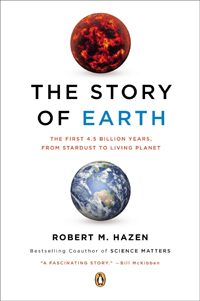 Robert M. Hazen, The Story of Earth: The First 4.5 Billion Years, From Stardust To Living Planet (New York: Viking, 2012), 306pp.
Robert M. Hazen, The Story of Earth: The First 4.5 Billion Years, From Stardust To Living Planet (New York: Viking, 2012), 306pp.
In 2021, data from NASA's New Horizons space probe suggested that the universe contains about 200 billion galaxies. The smallish Milky Way Galaxy contains 100 to 400 billion stars, and at least that many planets. Our relatively young earth, formed 4.5 billion years ago in "sudden episodes of unfathomable violence," is thus barely a blink in the time and space of a 13.7 billion-year-old cosmic drama. In many ways the earth is utterly unremarkable; it's "a drama that has been repeated countless trillions of times throughout the history of the universe."
And yet, as Robert Hazen affirms in his brain exploding book, the earth is truly precious and special. There's nothing else like it that we know of. "Earth is the only known planet with oceans of water, with an atmosphere rich in oxygen, with life." Only earth "became alive." It is "the only one of its kind in the solar system, if not the entire cosmos." And this tiny blue dot in the black void of space gave rise to sentient human beings who can unravel and understand these marvelous mysteries.
For 99.99% of the earth's history, humanity did not exist. Human evolution is small beer compared to cosmic evolution. And that's the overriding theme of Hazen's "biography" of our earth—4.5 billion years of inexorable and radical change, from a planet with no water or oxygen, to one that now has the perfect balance of both. Massive plate tectonics ("the continents are moving"). From a dozen minerals in the original dust and gas of our solar system to over 4,500 known mineral species on earth today. "From core to crust," writes Hazen, the earth is "incessantly mutable." There is beauty and symmetry in all this, like the nine planets orbiting our earth in the same plane. But there are also crazy anomalies, like Venus rotating backward compared to the other planets, or Neptune's moon Triton orbiting the earth in the opposite direction of the rest of the planets.
Hazen writes with an infectious enthusiasm for his subject matter. His book is an example of popular science written at the highest level. The science will be heavy sledding for readers like me, but he includes numerous anecdotes throughout the book that humanize his story. Like when he bought meteorites in Morocco on the black market. Or how as a senior in college he was one of the first humans to "touch the moon" when he helped examine the forty-five pounds of rocks that Apollo 11 brought back from the lunar surface.
A major takeaway from the book is what Hazen calls "the sociology of science," that is, the very human way that science is actually done—the many things we don't know, the guesswork and speculation that lead to bitter controversies and debates, the alternate claims and counterarguments, the "orthodox" paradigms that are replaced by former "heresies," and the occasional vanity, egoism, and careerism of a few (but sometimes very important) scientists.
Robert Hazen, a mineralogist and astrobiologist, is the Clarence Robinson Professor of Earth Science at George Mason University, and a senior scientist at the Carnegie Institution's Geophysical Laboratory. For more on this subject see my review of Michael Benson, Far Out; A Space Time Chronicle (New York: Abrams, 2009), 328pp.
Dan Clendenin: dan@journeywithjesus.net


